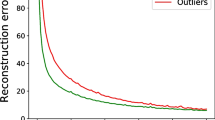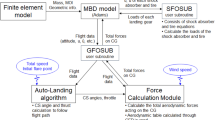Abstract
Detecting outliers of flight data is an important research field for flight safety. Deep learning methods have achieved remarkable performance in the outlier detection tasks for time series data. The majority of previous deep-learning-based outlier detection methods for flight data focus on either learning descriptive features by matching the distribution of inliers with autoencoder-based models, or learning semantic features by mapping inliers into a hyper-sphere with kernel functions, while the information of the given class samples is insufficiently utilized. To address this issue, in this paper, we propose a novel multi-task-based model that can jointly learn descriptive and semantic features. The proposed model is based on an LSTM autoencoder to reconstruct the inputs, and we design a constraining layer to pull the learned semantic features together. By jointly training two branches of the model, the proposed method can learn to fit the distribution of inputs as well as map inliers into a tight hyper-sphere, thus making outliers and inliers more distinguishable. Experimental results on the real flight dataset demonstrate the effectiveness of the proposed method compared to previous algorithms.



Similar content being viewed by others
Data availability
The dataset used in the manuscript is a public dataset that can be found at: https://conservancy.umn.edu/handle /11299/163580.
Notes
Retrieved from University of Minnesota Digital Conservancy, 2022. Available at https://conservancy.umn.edu/handle/11299/163580.
References
Budalakoti, S., Srivastava, A. N., & Otey, M. E. (2009). Anomaly detection and diagnosis algorithms for discrete symbol sequences with applications to airline safety. IEEE Transactions on Systems Man and Cybernetics Part C, 39(1), 101–113.
Matthews, B., Srivsatava, A.N., Schade, J., Schleicher, D.R., & Kiniry, M. (2013). Discovery of abnormal flight patterns in flight track data. In: 2013 Aviation Technology, Integration, and Operations Conference.
Li, L., Das, S., Hansman, R. J., Palacios, R., & Srivastava, A. N. (2015). Analysis of flight data using clustering techniques for detecting abnormal operations. Journal of Aerospace Computing, Information, and Communication, 12(9), 587–598.
Bay, S.D., & Schwabacher, M. (2003). Mining distance-based outliers in near linear time with randomization and a simple pruning rule. In: Proceedings of the Ninth ACM SIGKDD international conference on knowledge discovery and data mining (KDD-2003)
Olkopf, B.S., Williamson, R., Smola, A., Shawe-Taylor, J., & Platt, J. (2000). Support vector method for novelty detection. In: Advances in Neural Information Processing Systems.
Tax, D., & Duin, R. (1999). Support vector domain description. Pattern recognition letters.
Erfani, S. M., Rajasegarar, S., Karunasekera, S., & Leckie, C. (2016). High-dimensional and large-scale anomaly detection using a linear one-class SVM with deep learning. Pattern Recognition, 62, 121–134.
Camerini, V., Coppotelli, G., & Bendisch, S. (2018). Fault detection in operating helicopter drivetrain components based on support vector data description. Aerospace Science and Technology, 73, 48–60.
Ruff, L., Vandermeulen, R. A., Görnitz, N., Deecke, L., & Kloft, M. (2018). Deep one-class classification. International Conference on Machine Learning, 24, 11053.
Rong-Xiao, G. (2021). Anomaly detection method for UAV sensor data based on LSTM–OCSVM. Journal of Chinese Computer Systems, 85, 700–705.
Tu, Y., Lin, Y., Zha, H., Zhang, J., Wang, Y., Gui, G., & Mao, S. (2022). Large-scale real-world radio signal recognition with deep learning. Chinese Journal of Aeronautics, 35(9), 35–48.
Bao, Z., Lin, Y., Zhang, S., Li, Z., & Mao, S. (2022). Threat of adversarial attacks on dl-based IoT device identification. IEEE Internet of Things Journal, 9(11), 9012–9024. https://doi.org/10.1109/JIOT.2021.3120197
Liu, S., Li, Y., & Fu, W. (2022). Human-centered attention-aware networks for action recognition. International Journal of Intelligent Systems, 37, 10968–10987.
Wu, Q., Li, Y., Lin, Y., & Zhou, R. (2018). Weighted sparse image classification based on low rank representation. CMC Computer Materials Continua, 7, 15.
Luo, W., Wen, L., & Gao, S. (2017). Remembering history with convolutional LSTM for anomaly detection. In: 2017 IEEE International conference on multimedia and expo (ICME)
Shabtai, A., & Habler, I. Using LSTM encoder-decoder algorithm for detecting anomalous ADS-B messages
Jianli, D., Yunkai, Z., Jing, W., & Huaichao, W. (2019). Ads-b anomaly data detection model based on deep learning. Acta Aeronautica et Astronautica Sinica, 40(11), 452.
Zhong, J., Zhang, Y., Wang, J., Luo, C., & Miao, Q. (2022). Unmanned aerial vehicle flight data anomaly detection and recovery prediction based on spatio-temporal correlation. IEEE Transactions on Reliability, 1, 71.
Reddy, K.K., Sarkar, S., Venugopalan, V., & Giering, M. (2016). Anomaly detection and fault disambiguation in large flight data: A multi-modal deep auto-encoder approach. In: Annual Conference of the PHM Society.
Wang, X., Du, Y., Lin, S., Cui, P., Shen, Y., Yang, Y. (2019). Self-adversarial variational autoencoder with gaussian anomaly prior distribution for anomaly detection.
Donahue, J., Krhenbühl, P., & Darrell, T. (2016). Adversarial feature learning.
Wang Fengqin, W. L., & Long, G. (2022). UAV flight data anomaly detection algorithm based on LSTM–GAN. Journal of Chinese Inertial Technology, 45, 264–271.
Villa-Peacuterez, M.E.A.-C. (2021). Semi-supervised anomaly detection algorithms: A comparative summary and future research directions. Knowledge-Based Systems, 785, 106878.
Zhu, Y., Du, C., Liu, Z., Chen, Y.-B., & Zhao, Y. (2022). A turboshaft aeroengine fault detection method based on one-class support vector machine and transfer learning. Journal of Aerospace Engineering, 35, 04022085.
Jiang, Y., Liu, R., Le, N., & Zheng, Y. (2019). A method for the outlier flights detection of the final approach based on foqa data. In: 2019 IEEE 1st international conference on civil aviation safety and information technology (ICCASIT).
Zhanping, S. W. J. T. F. (2014). Flight data novelty detection method based on improved SVDD. Chinese Journal of Scientific Instrument, 35, 932–939.
Kou, L., Chen, J., & Qin, Y. (2022). The robust multi-scale deep-SVDD model for anomaly online detection of rolling bearings. Sensors, 22(15), 5681.
Zhou, Y., Liang, X., Zhang, W., Zhang, L., & Song, X. (2021). VAE-based deep SVDD for anomaly detection. Neurocomputing, 453, 131.
Ji, Y., Wang, L., Wu, W., Shao, H., & Feng, Y. (2020). A method for LSTM-based trajectory modelling and abnormal trajectory detection. IEEE Access, 99, 1–1.
Fried, A., & Last, M. (2021). Facing airborne attacks on ADS-b data with autoencoders. Computers and Security, 109(2), 102405.
Zhang, W., Hu, M., & Du, J. (2022). An end-to-end framework for flight trajectory data analysis based on deep autoencoder network. Aerospace Science and Technology, 127, 107726.
Memarzadeh, M., Matthews, B., & Avrekh, I. (2020). Unsupervised anomaly detection in flight data using convolutional variational auto-encoder.
Liu, S., Gao, P., Li, Y., Fu, W., & Ding, W. (2022). Multi-modal fusion network with complementarity and importance for emotion recognition. Information Sciences, 619, 679–694.
Novitasari, S., Do, Q.T., Sakti, S., Lestari, D., & Nakamura, S. (2018). Multi-modal multi-task deep learning for speaker and emotion recognition of tv-series data. In: 2018 Oriental COCOSDA—international conference on speech database and assessments.
Xing, H., Xiao, Z., Qu, R., Zhu, Z., & Zhao, B. (2022). An efficient federated distillation learning system for multi-task time series classification. IEEE Transactions on Instrumentation and Measurement, 1, 452.
Ling, C., Donghui, C., Fan, Y., & Jianling, S. (2021). A deep multi-task representation learning method for time series classification and retrieval. Information Sciences, 555, 17–32.
Fu, X., Peng, Y., Liu, Y., Lin, Y., Gui, G., Gacanin, H., & Adachi, F. (2023). Semi-supervised specific emitter identification method using metric-adversarial training. IEEE Internet of Things Journal, 12, 1–1.
Zhu, Q., Chen, J., Shi, D., Zhu, L., Bai, X., Duan, X., & Liu, Y. (2020). Learning temporal and spatial correlations jointly: A unified framework for wind speed prediction. IEEE Transactions on Sustainable Energy, 11, 509–523.
Wu, Q., Li, Y., & Lin, Y. (2019). Medical image restoration method via multiple nonlocal prior constraints. Journal of Intelligent and Fuzzy Systems, 38(4), 1–15.
Zheng, L., Hongzhi, W., Xiaoou, D., & Tianyu, M. (2021). Industrial time series determinative anomaly detection based on constraint hypergraph. Knowledge-Based Systems, 233, 107548.
Lindemann, B., Maschler, B., Sahlab, N., & Weyrich, M. (2021). A survey on anomaly detection for technical systems using LSTM networks. Computers in Industry, 131(3), 103498.
Smagulova, K., & James, A. P. (2019). A survey on LSTM memristive neural network architectures and applications. The European Physical Journal Special Topics, 228(10), 4568.
Geiger, B. C., & Kubin, G. (2020). Information bottleneck: Theory and applications in deep learning. Entropy (Basel, Switzerland), 22, 1408.
Chollet, F. (2015). Keras. https://keras.io.
Abadi, M., Barham, P., Chen, J., Chen, Z., & Zhang, X. (2016). Tensorflow: A system for large-scale machine learning. USENIX Association.
Kingma, D.P., & Ba, J. (2014). Adam: A method for stochastic optimization. CoRR abs/1412.6980.
Hou, C., Liu, G., Tian, Q., Zhou, Z., Hua, L., & Lin, Y. (2022). Multisignal modulation classification using sliding window detection and complex convolutional network in frequency domain. IEEE Internet of Things Journal, 9(19), 19438–19449.
Acknowledgements
This work is supported by The National Natural Science Foundation of China (No.62271499, No.61971432, No.62022092), The Young Elite Scientists Sponsorship Program by CAST (2020-JCJQ-QT-011).
Author information
Authors and Affiliations
Contributions
Long Gao proposed the idea and conducted the experiments. Congan Xu optimized the method and checked the manuscript. Fengqin Wang conducted the experimental comparison and checked the manuscript. Junfeng Wu and Hang Su discussed the idea and wrote the initial version of the paper.
Corresponding author
Ethics declarations
Conflict of interest
The authors declare no competing financial interests.
Additional information
Publisher's Note
Springer Nature remains neutral with regard to jurisdictional claims in published maps and institutional affiliations.
Rights and permissions
Springer Nature or its licensor (e.g. a society or other partner) holds exclusive rights to this article under a publishing agreement with the author(s) or other rightsholder(s); author self-archiving of the accepted manuscript version of this article is solely governed by the terms of such publishing agreement and applicable law.
About this article
Cite this article
Gao, L., Xu, C., Wang, F. et al. Flight data outlier detection by constrained LSTM-autoencoder. Wireless Netw 29, 3051–3061 (2023). https://doi.org/10.1007/s11276-023-03353-1
Accepted:
Published:
Issue Date:
DOI: https://doi.org/10.1007/s11276-023-03353-1




